Chernobyl, Episode 4, Sky Atlantic review - life in the death zone | reviews, news & interviews
Chernobyl, Episode 4, Sky Atlantic review - life in the death zone
Chernobyl, Episode 4, Sky Atlantic review - life in the death zone
The horror of the nuclear disaster spreads inwards and outwards

Chernobyl (Sky Atlantic) is the most unmissable show on TV. Perhaps it’s because the Soviet nuclear catastrophe in 1986 was so blood-freezingly horrific that the filmmakers didn’t need to fictionalise or exaggerate.
This penultimate episode was bad news for animal lovers. It opened with an elderly woman trying to milk a cow, only to be ordered at gunpoint to leave her home right away, because of the morbid threat of radiation. She reeled off a litany of historical famines, wars and invasions that she’d lived through, and concluded that she’d be damned if she was going to leave because of some invisible toxic cloud. Long story short, the cow it was that died, just another fragment of collateral damage in a nation that had absorbed unmeasurable quantities of suffering.
The cow wasn’t alone, because we also followed a group of soldiers hunting down radiation-poisoned animals, mostly lost and bewildered pets stranded in the disaster zone. Watching a tipper-truck full of dead animals being dumped into a pit and covered with liquid cement made miserable viewing.
 Meanwhile, desperate efforts to contain the fallout continued, but the secrecy and incompetence of the Moscow regime hampered relief efforts at every turn. The authorities seemed almost comically ill equipped to deal with any disaster, let alone one on this portentous scale. Of course it was inconceivable that they should approach the ideological enemy, the USA, for help. They had some success shovelling away radioactive waste with a moon-rover from the Soviet space programme, but they needed heftier equipment.
Meanwhile, desperate efforts to contain the fallout continued, but the secrecy and incompetence of the Moscow regime hampered relief efforts at every turn. The authorities seemed almost comically ill equipped to deal with any disaster, let alone one on this portentous scale. Of course it was inconceivable that they should approach the ideological enemy, the USA, for help. They had some success shovelling away radioactive waste with a moon-rover from the Soviet space programme, but they needed heftier equipment.
Bulldozers were borrowed from West Germany but immediately broke down, since the Russians had lied about the vast level of radiation, which could fry electronic circuitry within a couple of minutes. As the supervising official Shcherbina (Stellan Skarsgard, pictured above with Emily Watson) was appalled to learn, the official position was that “a global nuclear catastrophe is not possible in the Soviet Union.” Skasgard’s performance has been one of the joys of the series, as he has gradually thawed from hatchet-faced agent of the state to a brave, principled man who has come to understand the hideous human cost of the catastrophe.
It was left to the scientist Legasov (Jared Harris) to conclude that they would have to use “bio-robots” – humans, in other words – to do the dirty work, and scenes of soldiers frantically shovelling radioactive graphite while a geiger counter clattered hysterically were hair-tearingly tense. It emerged, too, that Legasov had known about a nuclear accident 10 years earlier which offered vital clues about reactor safety, though these were promptly classified top secret by the KGB. It dropped an additional burden of guilt onto his drooping shoulders.
It’s a catalogue of horrors, but Harris and Skarsgard have managed to sneak in some comradely warmth, and even flashes of gallows humour. The scientist Khomyuk (Emily Watson) is painstakingly digging out the facts about mistakes, cover-ups and political interference – the state won’t do it, but somebody has to.
The future of Arts Journalism
You can stop theartsdesk.com closing!
We urgently need financing to survive. Our fundraising drive has thus far raised £49,000 but we need to reach £100,000 or we will be forced to close. Please contribute here: https://gofund.me/c3f6033d
And if you can forward this information to anyone who might assist, we’d be grateful.

Subscribe to theartsdesk.com
Thank you for continuing to read our work on theartsdesk.com. For unlimited access to every article in its entirety, including our archive of more than 15,000 pieces, we're asking for £5 per month or £40 per year. We feel it's a very good deal, and hope you do too.
To take a subscription now simply click here.
And if you're looking for that extra gift for a friend or family member, why not treat them to a theartsdesk.com gift subscription?
more TV
 Blu-ray: The Sweeney - Series One
Influential and entertaining 1970s police drama, handsomely restored
Blu-ray: The Sweeney - Series One
Influential and entertaining 1970s police drama, handsomely restored
 I Fought the Law, ITVX review - how an 800-year-old law was challenged and changed
Sheridan Smith's raw performance dominates ITV's new docudrama about injustice
I Fought the Law, ITVX review - how an 800-year-old law was challenged and changed
Sheridan Smith's raw performance dominates ITV's new docudrama about injustice
 The Paper, Sky Max review - a spinoff of the US Office worth waiting 20 years for
Perfectly judged recycling of the original's key elements, with a star turn at its heart
The Paper, Sky Max review - a spinoff of the US Office worth waiting 20 years for
Perfectly judged recycling of the original's key elements, with a star turn at its heart
 The Guest, BBC One review - be careful what you wish for
A terrific Eve Myles stars in addictive Welsh mystery
The Guest, BBC One review - be careful what you wish for
A terrific Eve Myles stars in addictive Welsh mystery
 theartsdesk Q&A: Suranne Jones on 'Hostage', power pants and politics
The star and producer talks about taking on the role of Prime Minister, wearing high heels and living in the public eye
theartsdesk Q&A: Suranne Jones on 'Hostage', power pants and politics
The star and producer talks about taking on the role of Prime Minister, wearing high heels and living in the public eye
 King & Conqueror, BBC One review - not many kicks in 1066
Turgid medieval drama leaves viewers in the dark
King & Conqueror, BBC One review - not many kicks in 1066
Turgid medieval drama leaves viewers in the dark
 Hostage, Netflix review - entente not-too-cordiale
Suranne Jones and Julie Delpy cross swords in confused political drama
Hostage, Netflix review - entente not-too-cordiale
Suranne Jones and Julie Delpy cross swords in confused political drama
 In Flight, Channel 4 review - drugs, thugs and Bulgarian gangsters
Katherine Kelly's flight attendant is battling a sea of troubles
In Flight, Channel 4 review - drugs, thugs and Bulgarian gangsters
Katherine Kelly's flight attendant is battling a sea of troubles
 Alien: Earth, Disney+ review - was this interstellar journey really necessary?
Noah Hawley's lavish sci-fi series brings Ridley Scott's monster back home
Alien: Earth, Disney+ review - was this interstellar journey really necessary?
Noah Hawley's lavish sci-fi series brings Ridley Scott's monster back home
 The Count of Monte Cristo, U&Drama review - silly telly for the silly season
Umpteenth incarnation of the Alexandre Dumas novel is no better than it should be
The Count of Monte Cristo, U&Drama review - silly telly for the silly season
Umpteenth incarnation of the Alexandre Dumas novel is no better than it should be
 The Narrow Road to the Deep North, BBC One review - love, death and hell on the Burma railway
Richard Flanagan's prize-winning novel becomes a gruelling TV series
The Narrow Road to the Deep North, BBC One review - love, death and hell on the Burma railway
Richard Flanagan's prize-winning novel becomes a gruelling TV series
 The Waterfront, Netflix review - fish, drugs and rock'n'roll
Kevin Williamson's Carolinas crime saga makes addictive viewing
The Waterfront, Netflix review - fish, drugs and rock'n'roll
Kevin Williamson's Carolinas crime saga makes addictive viewing

Add comment